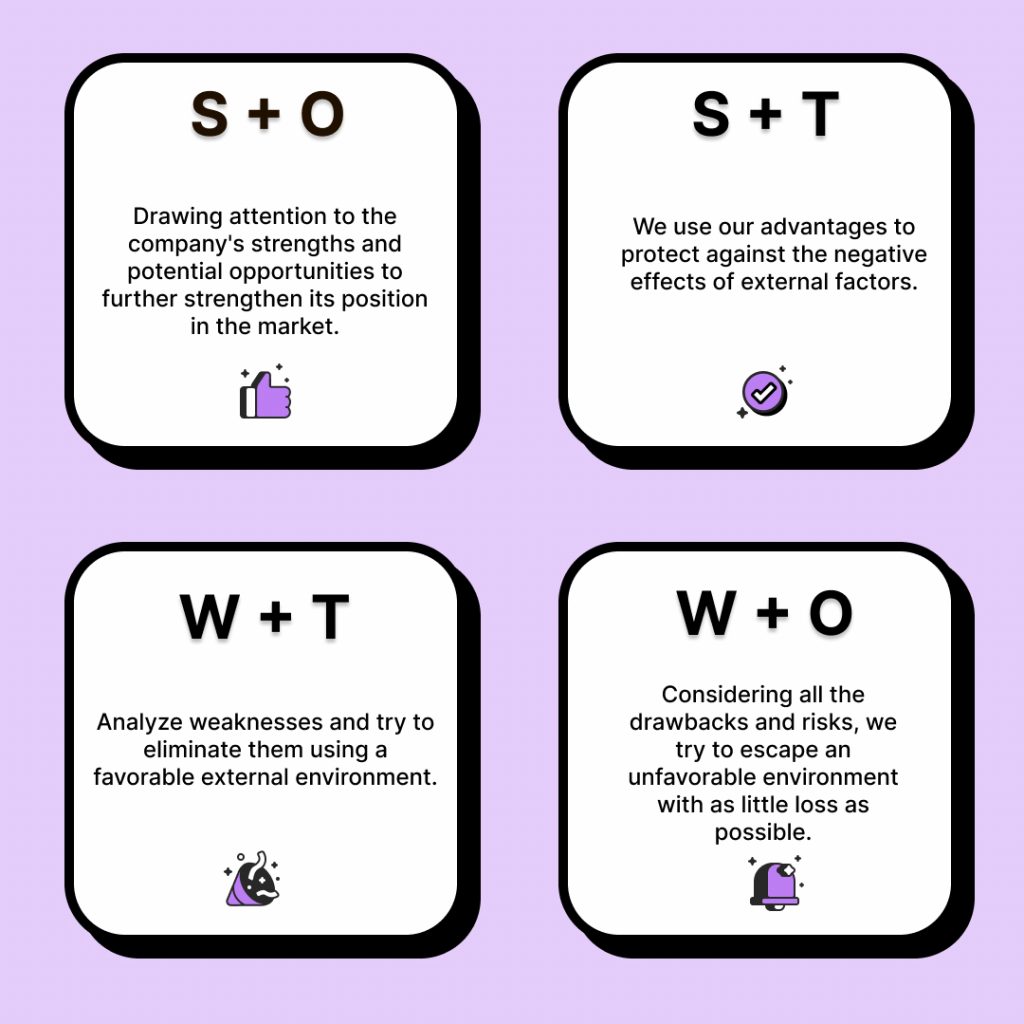
What is SWOT Analysis and How to Write it Correctly?
Table of Contents:
1.What Is SWOT Analysis?
2.The Building Blocks of SWOT Analysis
3.Who and Why Should Do a SWOT Analysis?
4.Writing a Well-Structured SWOT Analysis
5.Common Mistakes to Watch Out for in SWOT Analysis
What Is SWOT Analysis?
In a free market, doing business involves many risks. The presence of competitors, the rapid development of technology, and changes in consumer preferences all of this can have a significant impact on the financial results of the company.
Managers must use different tools to assess the current situation and predict future performance. SWOT analysis is one of the most important sources of information for making management decisions.
To begin with, we should decipher this acronym to understand better what we are going to talk about:
- S. Strengths, available assets;
- W. Weaknesses and shortcomings of the organization;
- O. Opportunities that can appear given the influence of external factors;
- T. Threats associated with potential risks and sudden changes in the market situation.
What is a SWOT analysis? It is one of the easiest ways to get detailed information for the strategic development plan of any organization. This approach is relevant for large industrial enterprises and companies that sell goods and provide services.
A visual representation of strengths and weaknesses in a matrix or list allows you to visualize the strengths and weaknesses. The same applies to threats and opportunities which can benefit the business.
The SWOT analysis is a universal tool for managers of different levels and marketers to plan for further action. In addition, many people use this methodology for personal evaluation.
The developer of such a matrix is considered to be Albert Humphrey. For ten years, beginning in 1960, he used the tool to compare large corporations in the United States. At that time, the purpose SWOT analysis was to obtain reliable information about the potential capabilities of companies. When the effectiveness of this type of brainstorming was proven, many organizations adopted it.
Today, most universities curricula consider this tool. Students are asked to choose an organization and conduct a detailed analysis. The SWOT analysis for students should be based on real-life examples. An abstract representation allows only a superficial understanding of the topic. But to get the most out of it, you should practice. For this, you will have to spend a lot of time. As a result, you will learn to quickly compile a matrix of weaknesses and strengths, potential risks, and opportunities.
Many teachers and top managers advise starting with a personality analysis. This is quite an interesting approach, which will help to raise self-esteem, clearly articulate life goals and find solutions to existing problems.
The SWOT analysis about yourself, as for companies, is done by completing a table in sequence. It consists of several blocks and nested lists. We will discuss the practical application of the method in more detail in one of the next sections of this review.
The Building Blocks of SWOT Analysis
This is one of the most important strategic planning tools in different spheres of life. SWOT analysis allows you to evaluate different aspects of the enterprise for the advantages used in a fair, competitive struggle. The information obtained improves the vision of the real situation and potential opportunities that can significantly improve the position of the company.
As previously mentioned, the acronym SWOT includes four aspects of analysis. Let’s consider each of them in the following table.

The SWOT matrix diagram allows you to assess the company’s strategic position. It is not a tool for operational planning, but a valuable resource for forming long-term goals.
The information obtained as a result of the analysis has the following impact on managerial decisions:
- identifying strengths allows you to get the most out of the available assets;
- identification of weaknesses provides an opportunity to revise the current strategy and select effective solutions to existing problems;
- analysis of opportunities helps unlock potential and gain a competitive advantage through innovative technologies;
- threat identification helps develop a step-by-step action plan when unforeseen circumstances arise.
You can view a ready-made SWOT analysis student example to understand each component better. Such information is publicly available online and published on many thematic sites.
The matrix consists of four blocks, each including an overview of one aspect of the analysis. The upper part looks at the positive and negative internal factors, and the lower part shows the risks and opportunities. This classic structure is found in books, online publications, and corporate reports.
Next, we will talk about the goal of the analysis, which should be involved in creating the matrix, where to take the information, and to whom to provide the finished report.
Recommended reading:
Who and Why Should Do a SWOT Analysis?
Often the initiator is the business owner or the board of directors. It all depends on the size of the company. Since this tool is quite versatile, it can be used by different company divisions. The results are provided to the head of the department, who develops a more effective management strategy.
As mentioned earlier, this topic is not only relevant to commercial organizations. It can be used to determine personal potential for career advancement.
It is necessary to understand that the goal of a SWOT analysis is to get the most basic information about all external and internal factors that directly or indirectly influence the business. Using this data, you can adjust your goals, acquire the necessary assets, and eliminate problems that hinder development.
Main reasons why every manager must apply this tool in their work:
- comprehensive assessment. Different indicators are considered, available assets are considered, and competitive advantages and weaknesses are identified. This allows you to get a clear picture of the real situation;
- strategic planning. Having received a report, a manager can intelligently reallocate resources, hire experienced specialists, and buy new equipment. All this will favorably affect financial results in the long term;
- correct company management. Very often, the cause of bankruptcy and reduced profits is the low qualification of managers. They don’t use analytical tools, don’t hold brainstorming sessions, or do other activities to improve corporate efficiency. SWOT analysis paper will help change the situation for the better, providing information to make informed decisions;
- understanding the relationship between internal and external factors. Even if a company uses innovative technology and has the right assets, this does not always guarantee success and prosperity. Customer preferences, as well as the current market environment, must be taken into account;
- identification of competitive advantages. Even one feature of a company can sometimes turn everything upside down. The main thing is objectively assessing other organizations, not underestimating their merits and achievements. Only in this way can you get relevant data and identify your strengths, on which you can bet in the competition;
- the right allocation of resources. What are opportunities in a SWOT analysis? These are external factors that have a positive impact on the company. Taking them into account, you can adjust the work of some departments to improve production and sales efficiency;
- risk reduction. Assessment of external threats is critical in the analysis. It lets you remove “rose-colored glasses” and see the real picture. You can suffer great financial losses if you stake only in strengths and potential opportunities. That’s why you must consider the market situation, analyze supply and demand, and influence legislation on the concrete business sphere.
In addition, SWOT analysis helps establish communication between the various enterprise departments. Managers begin to cooperate more closely, considering the updated strategic plan. Each side expresses its opinion, offers a list of improvements, and provides information on available resources. As a result, the company creates a step-by-step algorithm of actions to use assets and solve possible problems effectively in the shortest possible time.

Writing a Well-Structured SWOT Analysis
At first glance, this procedure may seem very simple. It all depends on the scale of the company. You can handle the task in just an hour if you evaluate yourself.
But how to write a SWOT analysis paper for a large enterprise? We recommend using the following algorithm:
- Determine who is in charge. If you are the manager or owner of the organization, then you should make a list of the departments and employees responsible for providing the information needed for the analysis. The more experts involved, the more accurate the results will be. If you don’t want to handle this issue yourself or don’t have time for such actions, you can delegate authority to direct subordinates or a freelancer;
- Create a table. The classic version consists of two columns and two rows of equal size. It can be drawn on paper or filled in the matrix on the computer. In addition, many free applications allow you to write SWOT analysis. This is very handy because you can give different employees access to the document and enter data in parallel to speed up the process;
- Analyze every aspect of your business. If there is a lot of information, divide it into categories and schedule meetings with responsible managers to discuss important issues. We highly recommend using different brainstorming techniques to increase the efficiency of this step;
- Group the data and fill in the matrix. Some strengths can be combined into one item so that the list looks compact and does not mislead the manager;
- Print out the table and distribute it to your decision-making colleagues. If using an app, share the link in a corporate messenger, or use any standard method of communication.

And now, it’s worth looking at the third item on the previous list. How to write a SWOT analysis correctly and not miss important details? It is necessary to analyze all aspects of the company. And to do this, it is necessary to find answers to the following questions, which are given as an example:
- What kind of feedback about the organization is prevalent in the community?
- Why isn’t the previously used sales strategy working?
- What achievements can we brag about to our competitors?
- Are new technologies being used to improve productivity?
- Is there enough demand for the products or services offered?
- Why are employees constantly being laid off, and no new ones can be found?
- Are there particularities in local laws that may affect the business?
- Is delivering goods on your transport profitable, or is it better to use private carriers?
There are hundreds of such issues to consider to write a SWOT analysis. Again, we are talking about large enterprises. In the simplest case, their number would be a few dozen. But the more details are considered, the more accurate the results will be. And this will make it possible to make the right decisions and increase business productivity.
After filling out the matrix, you can assign each item a certain number of points, depending on its impact on the corporation. If you work with a team, offer all employees to assign scores and then calculate the average value for each factor.
In our SWOT review, you should also be sure to divide the results of the analysis into groups for subsequent decision-making:

Or each cell of the matrix can be evaluated separately. It all depends on the study’s goals, which are determined before the analysis begins.
Common Mistakes to Watch Out for in SWOT Analysis
Many marketers or business unit managers often make serious mistakes when doing a SWOT analysis. This can have dire consequences if the wrong decisions are made. Here is a list of points worth paying special attention to:
- failure to take into account competitor’s strengths. If you overlook the weaknesses of other organizations, it is not so critical. But the lack of information about strong positions can hurt the analysis results. You need to pay attention to new players who have just entered the market. Do not forget about the so-called “Amazon phenomenon,” when a corporation can expand its influence on uncharacteristic niches;
- no comprehensive evaluation is used. Each matrix cell is evaluated separately, not considering information from neighboring blocks. This is a big mistake, leading to a distorted view of strengths and weaknesses;
- incorrect goal-setting and choice of implementers. Initially, it is worth deciding on the direction of the study. You can’t just order the managers to writing a SWOT. You have to find out which departments should be involved and who will be affected by the decisions you make;
- poor assessment of external factors. They may have a strong impact on the company. But many managers miss important details and consider only the information that lies on the surface;
- violation of the analysis algorithm. Earlier, we talked about the sequence of actions. You can get incorrect results if you skip one of the steps or perform them in a different order.
It is recommended first to examine all the strengths and weaknesses to find possible solutions. And only after that consider the opportunities and threats. This will allow you not to get confused with a variety of information. You will spend much less time if you do the SWOT analysis gradually, moving from one stage to the next.
Only professional ‘write my paper‘ services with experienced writers can guarantee you results. Bid4Papers remains the highest quality.
